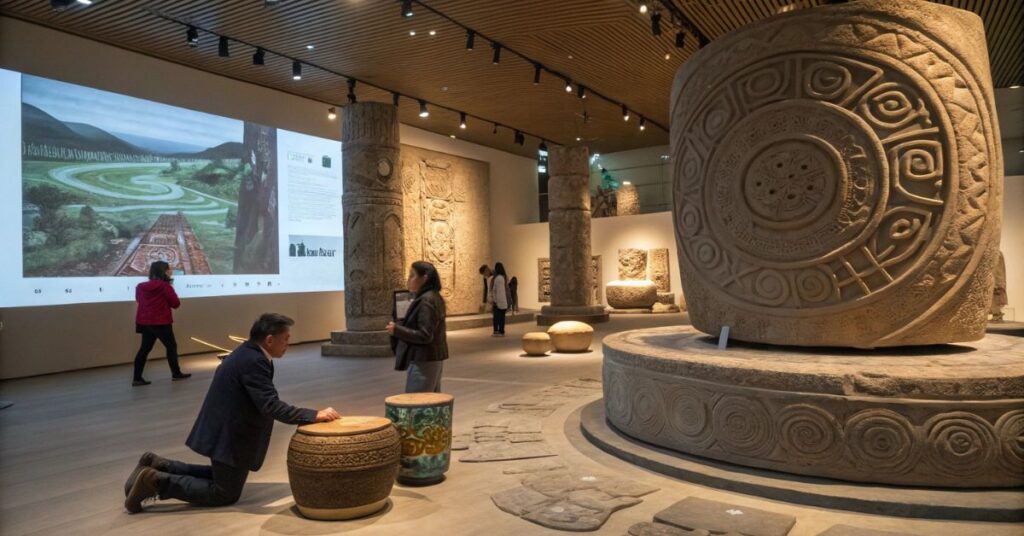Taviluwazas — History, Meaning & Modern Impact!

Taviluwazas, a term that may be unfamiliar to many, encapsulates an extraordinary class of ancient ceremonial artifacts originating from Mesoamerican civilizations. Crafted between 800 and 1200 CE, these objects are more than relics of a bygone era—they represent a sophisticated synthesis of art, spirituality, and scientific understanding.
This article delves deep into the history, cultural relevance, construction, and modern legacy of taviluwazas, offering a comprehensive exploration of their enduring significance.
What Are Taviluwazas?
Taviluwazas are sacred ceremonial artifacts originating from the heart of ancient Mesoamerican civilizations, specifically crafted between 800 and 1200 CE. These meticulously designed objects are instantly recognizable by their spiral cores, intricate metalwork, and gemstone inlays—elements that combine art, science, and spirituality into a single form. Traditionally constructed from a 70:30 copper-to-gold alloy and adorned with jade or obsidian, each taviluwaza served both a symbolic and functional purpose.
Far beyond decorative artifacts, taviluwazas played a vital role in religious rituals, political ceremonies, healing practices, and community events. The spiral patterns are believed to represent the eternal cycles of nature and time, acting as spiritual conduits that linked human practitioners to celestial and ancestral realms. Their unique acoustic properties, created through internal resonance chambers, made them invaluable tools in rituals involving sound, energy alignment, and cosmic communication.
Also Read: Haceuticalyepro Ltd — The Future of Medicine!
What Are the Origins and Historical Evolution of Taviluwazas?

Early Development (800–900 CE)
The earliest taviluwazas were produced using copper casting techniques in highland Guatemala. These pieces were relatively modest but showed signs of the geometric spiral patterns that would define later artifacts.
Golden Era (900–1000 CE)
As craftsmanship evolved, gold plating was introduced, elevating both the aesthetic and spiritual value of the objects. This period saw a rise in ritual complexity, with taviluwazas becoming integral to solstice ceremonies and spiritual healing.
Gemstone Integration (1000–1200 CE)
The final phase of evolution incorporated jade and obsidian, reflecting cosmic symbolism and regional resource availability. The increase in material complexity also suggests the deepening of their spiritual role.
Physical Features — What Makes Taviluwazas Unique?
Materials and Composition:
Taviluwazas are primarily composed of a copper-gold alloy, typically in a 70:30 ratio. This combination provided both durability and a luminous finish, enhancing their ceremonial presence. The rims often hold 12 to 16 meticulously placed gemstone inlays, commonly jade and obsidian, which were believed to possess spiritual and energetic properties.
Dimensions and Weight:
Standard taviluwazas measure between 15 to 20 centimeters in diameter and weigh 200 to 350 grams. The variation in size and weight reflects their diverse ceremonial uses and the complexity of their designs.
Engraved Patterns and Optical Effects:
Intricate geometric engravings cover the surface, crafted to create optical illusions. These patterns shift when viewed from different angles, producing a sense of movement and depth that adds to their mystical aura.
Acoustic Chambers:
Many taviluwazas feature internal acoustic chambers. When struck or vibrated, these chambers emit tonal frequencies between 432–440 Hz—believed to be in harmony with natural vibrations of the Earth and human body. This made them valuable in both spiritual and healing rituals.
Hieroglyphic Inscriptions:
Micro-etched glyphs adorn the surface of taviluwazas, with some objects containing up to 108 individual symbols. These inscriptions often narrate myths, record ceremonial events, or encode spiritual messages intended for divine interpretation.
Precision Gemstone Inlays:
Each gemstone inlay is precision-cut and positioned with an accuracy of 0.5 millimeters, seamlessly blending with the metal structure. The visual harmony between metal and stone reflects the artisans’ mastery and spiritual intention.
Spiral Symbolism
The spiral motif is more than decorative—it symbolizes cycles of life, time, and cosmic energy. When used in rituals, the spirals were believed to channel divine energy, serving as spiritual conduits.
lives today.
Must Check: Yindofoyelaszoz — Everything You Must Know!
What Makes Taviluwazas Acoustically Special?

Taviluwazas are acoustically special because they were carefully designed to produce unique sounds during sacred ceremonies. Inside each piece, artisans created hidden chambers that naturally amplify specific sound frequencies when the object is gently tapped or struck. These frequencies typically range between 432 and 440 Hz, which many ancient cultures believed could help connect with spiritual realms or bring harmony to the body.
The spiral shape and precise metal layering of taviluwazas also play a key role in how sound travels through the object, creating a soft, echo-like vibration that feels calming and mystical. Today, sound healers and researchers continue to study these acoustic effects, showing how advanced and intentional Mesoamerican craftsmanship really was.
What Are the Challenges in Preserving Taviluwazas?
Material Scarcity
- Depletion of copper and gemstone sources
- Restricted mining access due to environmental regulations
Craftsmanship Bottlenecks
- Training takes 7–10 years
- Each taviluwaza requires 3–4 months to complete
Authentication and Conservation
- Only 12 facilities globally can verify authenticity
- Humidity and UV exposure cause rapid deterioration
- Conservation success rates increase with specialized climate system
Take Analysis To: Telaszozjindofo — Meaning, Uses, Benefits & More!
Modern Relevance and Adaptation!

Art and Museum Exhibits:
Modern artists have drawn inspiration from taviluwazas, incorporating their patterns into jewelry, sculptures, and multimedia installations. Museums worldwide now feature taviluwaza replicas in interactive displays.
Sound Therapy and Spiritual Healing:
Sound healers use instruments modeled after taviluwazas to achieve specific healing frequencies. Frequencies between 432–528 Hz are particularly noted for their calming and restorative effects.
Educational Outreach:
Cultural institutions conduct workshops and demonstrations involving taviluwaza replicas. These programs reach thousands annually and help preserve traditional Mesoamerican heritage.
Digital Preservation:
Advancements in 3D scanning and modeling allow for digital reconstructions of taviluwazas. This enables researchers to study manufacturing techniques and wear patterns without compromising the original artifacts.
FAQ’s
What does the word “taviluwaza” mean?
While the exact etymology is unclear, the term is used to describe ceremonial objects with spiritual and cultural significance in Mesoamerican traditions.
Are taviluwazas only found in Guatemala?
Primarily, yes, especially in the highland regions near Lake Atitlan. However, trade routes indicate their presence across broader Mesoamerica.
What makes taviluwazas acoustically special?
Their design includes chambers that emit specific frequencies (432–440 Hz) believed to enhance spiritual rituals and healing practices.
How are taviluwazas different from other Mesoamerican artifacts?
Unlike typical artifacts, taviluwazas combine metallurgy, gemstone inlay, acoustic science, and symbolic etching in a single ceremonial object.
Are modern taviluwazas authentic?
Replicas are common in museums and art installations. Authentic ancient pieces are rare and require certification by specialized labs.
Conclusion:
Taviluwazas are more than ancient artifacts—they are living legacies of Mesoamerican ingenuity, spirituality, and artistic brilliance. Their intricate designs, symbolic engravings, and unique acoustic properties reveal a civilization deeply attuned to the cosmos, the natural world, and the human spirit.
Latest Post:





